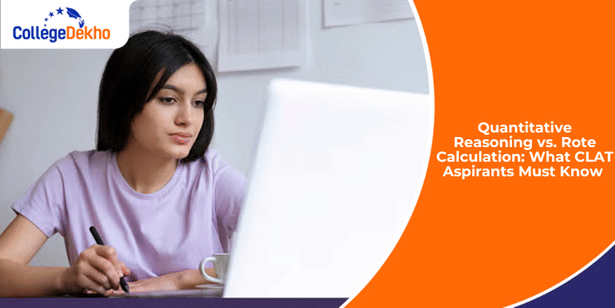
Quantitative Reasoning vs Rote Calculation analysis can help you devise a CLAT exam strategy that will significantly improve your overall exam score. That is why understanding both these methods and choosing the right one for you is crucial during the CLAT preparation stage. Quantitative Reasoning can help you tackle nearly all types of questions in CLAT since you will be approaching the problem from a logical point of view. However, with rote calculation, you will be saving a lot of time in a few areas, which is also important for a time-based exam like CLAT.
Also Read: Time Management Tips for CLAT 2026 Quantitative Techniques
Quantitative Reasoning vs. Rote Calculation Analysis for CLAT
A detailed analysis of both quantitative reasoning and rote calculation will help you understand which of these two methods is better for CLAT. Check the table below for a detailed comparison:
Particulars | Quantitative Reasoning | Rote Calculation |
|---|---|---|
Definition | Involves understanding concepts, interpreting data, and applying logical reasoning to solve problems. | Involves applying memorized formulas or standard methods without deep conceptual understanding. |
Skill Focus | Analytical thinking, pattern recognition, and problem-solving strategies. | Memorization of formulas, shortcuts, and standard calculation steps. |
Approach | Conceptual: understand why and how a solution works. | Procedural: follow the steps mechanically to get an answer. |
Problem Types | Word problems, puzzles, data interpretation, and logical scenarios. | Standard numerical problems, formula-based calculations. |
Flexibility | High: multiple approaches can be used to solve a problem. | Low: rigid reliance on memorized steps; errors are likely if the problem deviates slightly. |
Time Efficiency | Often faster in competitive exams when reasoning shortcuts are used. | Can be slower for complex problems; prone to calculation errors. |
Exams Relevance | CLAT, GMAT, CAT, and aptitude sections emphasizing reasoning and logic. | School exams, basic arithmetic tests, or where speed and formula use dominate. |
Example | Figuring out averages, ratios, or probability using logic rather than a direct formula. | Directly calculating (15×24)/6(15 \times 24) / 6(15×24)/6 using memorized multiplication/ division rules. |
CLAT 2026 Quant Preparation Tips
Check out the CLAT quantitative techniques preparation tips mentioned below:
Focus Area | Preparation Tips | Reasoning / Notes |
|---|---|---|
Approximation & Elimination | Learn to approximate answers and eliminate wrong options quickly. | Useful when exact calculations are time-consuming. |
Avoid Over-Reliance on Formulas | Focus on understanding concepts rather than rote formulas. | CLAT emphasizes logical reasoning more than heavy calculation. |
Concept Clarity | Revise fundamental topics: percentages, ratios, averages, time-speed-distance, probability, data interpretation, and simple algebra. | CLAT rarely tests very advanced formulas; strong basics save time. |
Data Interpretation | Focus on tables, graphs, and charts; practice spotting trends and averages. | About 5–6 questions often come from statistical reasoning. |
Mock Tests & Revision | Take weekly mock tests; analyze mistakes carefully. | Builds exam temperament and highlights weak areas. |
Practice with Variety | Solve different types of questions: word problems, tables, graphs, and puzzles. | Exposure to multiple formats improves adaptability during the exam. |
Previous Year Papers | Solve past 5–7 years’ CLAT papers for pattern recognition. | Helps identify frequently asked topics and question difficulty. |
Regular Practice | Daily 30–45 minutes of focused quantitative problem-solving. | Consistency beats cramming before exams. |
Shortcut Techniques | Memorize mental math tricks for fractions, percentages, and ratios. | Saves 30–60 seconds per question over multiple problems. |
Speed & Accuracy | Time each practice set; target 1–2 min per easy question, 2–3 min for complex ones. | CLAT is time-bound; practice prevents getting stuck on tricky problems. |
We hope this article was able to provide you with some clarity on Quantitative Reasoning vs. Rote Calculation. Check the links below to learn more about CLAT 2026!
Related Articles:
For any admission-related guidance, call our toll-free number 1800-572-9877, or fill out our Common Application Form (CAF) . Stay tuned with CollegeDekho for more updates related to UG/PG admission and colleges!
Are you feeling lost and unsure about what career path to take after completing 12th standard?
Say goodbye to confusion and hello to a bright future!

FAQs
Strategies for CLAT graph and table interpretation include: analyzing headings, calculating totals/averages, spotting trends, using approximations, cross-checking ratios, eliminating impossible options, and prioritizing easy questions for time efficiency.
To improve calculation skills for CLAT, practice daily with mental math, Vedic tricks, and approximation methods. Focus on quick percentage conversions, fraction-decimal equivalence, and ratio handling. Timed practice with DI sets enhances both speed and accuracy under pressure.
You should begin CLAT Quant preparation with core basics: percentages, ratios, proportions, averages, and simple interest/compound interest. Next, move to profit-loss, time-speed-distance, and fractions. Once fundamentals are strong, practice data interpretation, graphs, and case-based quantitative reasoning for exam-focused application.
The CLAT Quantitative Techniques section is of moderate difficulty. It tests basic arithmetic, percentages, ratios, averages, and data interpretation. While concepts are simple, the challenge lies in quick logical application, accuracy, and time management.
Quantitative Reasoning is far better than rote calculation for CLAT. The exam emphasizes logic, interpretation of data, and application of concepts over repetitive arithmetic. Strong reasoning saves time, improves accuracy, and helps tackle diverse graph, table, and statistics-based questions.
Was this article helpful?





















Similar Articles
Expected rank for 30 marks in SLAT 2026
UGC NET Law December 2025 Most Important Topics for Last Minute Revision
Expected rank for 40 marks in SLAT 2026
Expected rank for 50 marks in SLAT 2026
What is a Good Score in SLAT 2026?
Government Jobs after LLB